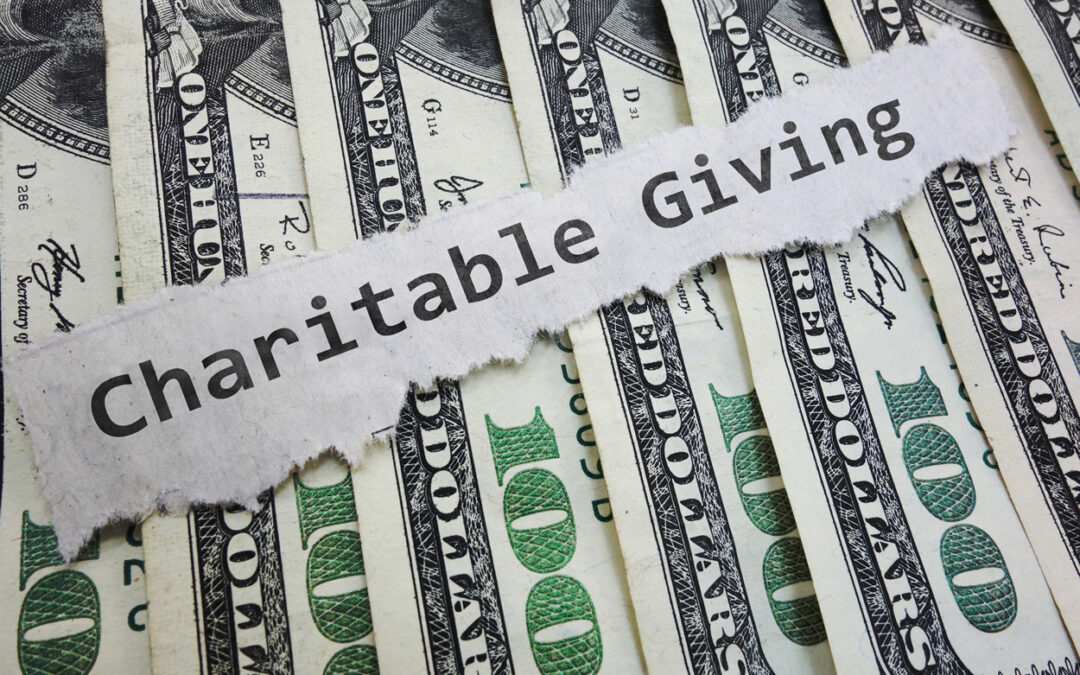
by sreamercpa | Nov 29, 2021 | IRS
Some important things all taxpayers should do before the tax year ends
The IRS reminds taxpayers there are things they should do before the current tax year ends on Dec.31.
Donate to charity
Taxpayers may be able to deduct donations to tax-exempt organizations on their tax return. As people are deciding where to make their donations, the IRS has a tool that may help. Tax Exempt Organization Search on IRS.gov allows users to search for charities. It provides information about an organization’s federal tax status and filings.
The law now permits taxpayers to claim a limited deduction on their 2021 federal income tax returns for cash contributions they made to certain qualifying charitable organizations even if they don’t itemize their deductions. Taxpayers, including married individuals filing separate returns, can claim a deduction of up to $300 for cash contributions to qualifying charities during 2021. The maximum deduction is $600 for married individuals filing joint returns.
Most cash donations made to charity qualify for the deduction. However, there are some exceptions. Cash contributions include those made by check, credit card or debit card as well as unreimbursed out-of-pocket expenses in connection with volunteer services to a qualifying charitable organization.
Check Individual Taxpayer Identification Number
An ITIN only needs to be renewed if it has expired and is needed on a U.S. federal tax return.
If an Individual Taxpayer Identification Number was not included on a U.S. federal tax return at least once for tax years 2018, 2019 and 2020, the ITIN will expire on Dec. 31, 2021.
As a reminder, ITINs with middle digits 70 through 88 have expired. In addition, ITINs with middle digits 90 through 99, if assigned before 2013, have expired. Individuals who previously submitted a renewal application that was approved, do not need to renew again.
Find information about retirement plans
IRS.gov has end-of-year tax information about retirement plans. This includes resources for individuals about retirement planning, contributions and withdrawals.
Contribute salary deferral
Taxpayers can make a salary deferral to a retirement plan. This helps maximize the tax credit available for eligible contributions. Taxpayers should make sure their total salary deferral contributions do not exceed the
$19,500 limit for 2021.
Get banked and set up direct deposit
Direct deposit gives taxpayers access to their refund faster than a paper check. Those without a bank account can learn how to open an account at an FDIC-Insured bank or through the National Credit Union Locator Tool.
Veterans should see the Veterans Benefits Banking Program for access to financial services at participating banks.
Connect with the IRS
Taxpayers can use social media to get the latest tax and filing tips from the IRS. The IRS shares information on things like tax changes, scam alerts, initiatives, tax products and taxpayer services. These social media tools are available in different languages, including English, Spanish and American Sign Language.
Think about tax refunds
Taxpayers should be careful not to expect getting a refund by a certain date. This is especially true for those who plan to use their refund to make major purchases or pay bills. Just as each tax return is unique to the individual, so is each taxpayer’s refund. Taxpayers can take steps now to Get Ready to file their federal tax return in 2022.

by sreamercpa | Nov 6, 2021 | IRS
Year-end giving reminder: Special tax deduction helps most people give up to $600 to charity, even if they don’t itemize
WASHINGTON – The Internal Revenue Service today reminded taxpayers that a special tax provision will allow more Americans to easily deduct up to $600 in donations to qualifying charities on their 2021 federal income tax return.
Ordinarily, people who choose to take the standard deduction cannot claim a deduction for their charitable contributions. But a temporary law change now permits them to claim a limited deduction on their 2021 federal income tax returns for cash contributions made to qualifying charitable organizations. Nearly nine in 10 taxpayers now take the standard deduction and could potentially qualify.
Under this provision, individual tax filers, including married individuals filing separate returns, can claim a deduction of up to $300 for cash contributions made to qualifying charities during 2021. The maximum deduction is increased to $600 for married individuals filing joint returns.
Included in the Coronavirus Aid, Relief, and Economic Security (CARES) Act, enacted in March 2020, a more limited version of this temporary tax benefit originally only applied to tax-year 2020. The Taxpayer Certainty and Disaster Tax Relief Act of 2020, enacted last December, generally extended it through the end of 2021.
Cash contributions include those made by check, credit card or debit card as well as amounts incurred by an individual for unreimbursed out-of-pocket expenses in connection with their volunteer services to a qualifying charitable organization. Cash contributions don’t include the value of volunteer services, securities, household items or other property.
The IRS reminds taxpayers to make sure they’re donating to a recognized charity. To receive a deduction, taxpayers must donate to a qualified charity. To check the status of a charity, they can use the IRS Tax Exempt Organization Search tool.
Cash contributions to most charitable organizations qualify. But contributions made either to supporting organizations or to establish or maintain a donor advised fund do not. Contributions carried forward from prior years do not qualify, nor do contributions to most private foundations and most cash contributions to charitable remainder trusts.
In general, a donor-advised fund is a fund or account maintained by a charity in which a donor can, because of being a donor, advise the fund on how to distribute or invest amounts contributed by the donor and held in the fund. A supporting organization is a charity that carries out its exempt purposes by supporting other exempt organizations, usually other public charities.
Keep good records Special recordkeeping rules apply to any taxpayer claiming a charitable contribution deduction. Usually, this includes obtaining an acknowledgment letter from the charity before filing a return and retaining a cancelled check or credit card receipt for contributions of cash. For details on the recordkeeping rules for substa

by sreamercpa | Sep 29, 2021 | accounting-tax
Criminals and fraudsters often see disasters as an opportunity to take advantage of victims when they are the most vulnerable, as well as the generous taxpayers who want to help with relief efforts.
These disaster scams normally start with unsolicited contact. The scammer contacts their possible victim by telephone, social media, email or in-person. Also, taxpayers may search for a charity online and be directed to a website or social media page that is not affiliated with the actual charity.
Here are some tips to help taxpayers recognize a scam and avoid becoming a victim:
- Some thieves pretend they are from a charity. They do this to get money or private information from well-intentioned taxpayers.
- Bogus websites use names like legitimate charities. They do this scam to trick people to send money or provide personal financial information.
- Scammers even claim to be working for ― or on behalf of ― the IRS. The thieves say they can help victims file casualty loss claims and get tax refunds.
- Disaster victims can call the IRS toll-free disaster assistance line at 866-562-5227. Phone assistors will answer questions about tax relief or disaster-related tax issues.
- Taxpayers who want to make donations can get information to help them on IRS.gov. The Tax Exempt Organization Search helps users find or verify qualified charities. Donations to these charities may be tax-deductible.
- Taxpayers should always contribute by check or credit card to have a record of the tax-deductible donation if they choose to give money. individual taxpayers can deduct up to $300 and married couples can deduct up to $600 in qualifying charitable contributions for tax year 2021 even if they don’t itemize.
- Donors should not give out personal financial information to anyone who solicits a contribution. This includes things like Social Security numbers or credit card and bank account numbers and passwords.
More Information:
National Center for Disaster Fraud
www.disasterassistance.gov

by sreamercpa | Aug 30, 2021 | IRS
September is National Preparedness Month. With the height of hurricane season fast approaching and the ongoing threat of wildfires in some parts of the country, the Internal Revenue Service reminds everyone to develop an emergency preparedness plan.
All taxpayers, from individuals to organizations and businesses, should take time now to create or update their emergency plans.
Taxpayers can begin getting ready for a disaster with a preparedness plan that includes securing and duplicating essential tax and financial documents, creating lists of property and knowing where to find information once a disaster has occurred. Securing this information can help in the aftermath of a disaster, and it can help people more quickly take advantage of disaster relief available from the IRS.
Start secure
Taxpayers should keep critical original documents inside waterproof containers in a secure space. Documents such as tax returns, birth certificates, deeds, titles and insurance policies should also be duplicated and kept with a trusted person outside the area a natural disaster may affect.
Make copies
If original documents are available only on paper, taxpayers can use a scanner and save them on a USB flash drive, CD or in the cloud, which provide security and easy portability.
Document valuables
After a disaster hits, photographs and videos of a home or business’s contents can help support claims for insurance or tax benefits. All property, especially expensive and high- value items, should be recorded. The IRS disaster-loss workbooks can help individuals (.pdf) and businesses (.pdf) compile lists of belongings or business equipment.
Employer fiduciary bonds
Employers using payroll service providers should check if their provider has a fiduciary bond in place to protect the employer in the event of a default by provider. Employers are encouraged to create an Electronic Federal Tax Payment System account at EFTPS.gov to monitor their payroll tax deposits and receive email alerts.
Know where to go
Reconstructing records after a disaster may be required for tax purposes, getting federal assistance or insurance reimbursement. Find out if financial institutions provide statements and documents electronically. Taxpayers who have lost some or all of their records during a disaster should visit IRS’ Reconstructing Records webpage.
IRS is ready to help
Taxpayers living in a federally declared disaster can visit the IRS Tax Relief in Disaster Situations webpage or Around the Nation on IRS.gov and check for the available disaster tax relief. The IRS automatically identifies taxpayers located in the covered disaster area and applies filing and payment relief. Affected taxpayers can call 866-562-5227 to speak with an IRS specialist trained to handle disaster-related issues.
A taxpayer impacted by a disaster outside of a federally declared disaster area may qualify for disaster relief. This includes taxpayers who are not physically located in a disaster area, but whose records necessary to meet a filing or payment deadline postponed during the relief period are located in a covered disaster area.
For more information about National Preparedness Month, visit Ready.gov/September.

by sreamercpa | Aug 16, 2021 | child-tax-payments
If you didn’t get your August advance child tax credit in your bank account today, you’re not alone. Due to “an issue,” a percentage—less than 15%—of folks who got their payment by direct deposit in July will be mailed paper checks for the August payment, according to an Internal Revenue Service news release. Another way to put it: More than 4 million families will have to wait for a paper check. That could be at the end of August. “For those receiving their payments by paper check, be sure to allow extra time for delivery by mail through the end of August,” the IRS says.
The first batch of advance monthly payments sent out in July worth roughly $15 billion reached about 35 million families. About 86% (30 million families) got their July payments by direct deposit. That would work out to 4.5 million folks stuck waiting for their August payments. The IRS says it expects to have a fix before September, so for those affected, September payments will resume by direct deposit.
Most families will see the August direct deposit payments in their accounts starting today, August 13. Subsequent payment dates are: September 15, October 15, November 15 and December 15.
Normally you get the Child Tax Credit when you file your tax return (you’d get the 2021 credit in the spring of 2022 when you file your 2021 tax return). But the American Rescue Act both increased the tax credit dollar amount and included a provision to make half of the credit available as advance payments on a monthly basis starting July 15—for 2021.
The expanded credit provides parents with a $3,000 credit ($250/month) for every child age 6 to 17, and $3,600 ($300/month) for every child under age 6 (that’s up from $2,000 per dependent child up to age 16). Individuals earning up to $75,000 a year, heads of household up to $112,500 a year, and joint filers up to $150,000 a year are eligible to receive the full amount of the enhanced credit. The credit is nonrefundable, meaning you don’t need income to receive it (normally to take advantage of a tax credit you need income that it would offset). Earn too much to get the enhanced credit? The advance payments apply to the basic $2,000/year child tax credit, too. That phases out at $440,000 of income for a couple.
Didn’t get a July payment? Families who did not get a July payment and are getting their first monthly payment in August will still receive their total advance payment for the year. This means that the total payment will be spread over five months, rather than six, making each monthly payment larger.
Some families will get two August payments. In another fix, the IRS is correcting an issue regarding payments for families where the parent(s) have an Individual Taxpayer Identification Number and the qualifying children have a Social Security number. For these families who didn’t not get a July payment, they should get a monthly payment in August, which includes a portion of the missed July payment. They should get the remainder of the July payment in late August.
Keep in mind—the advance child tax credit is an advance, meaning you could get a smaller refund or owe more when you file your 2021 taxes next spring. To decline advance payments or to update your bank account information, go directly to the IRS Child Tax Credit Update Portal or access it from the IRS’ Advanced Child Tax Credit Payments In 2021 page.





